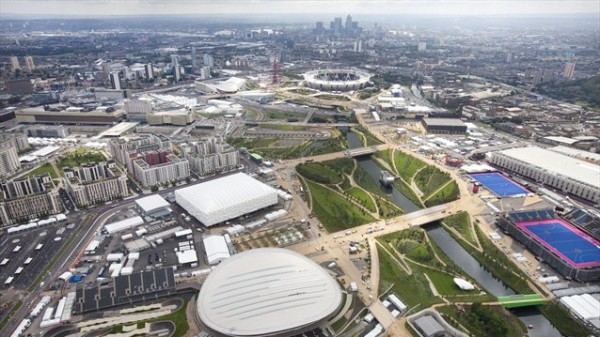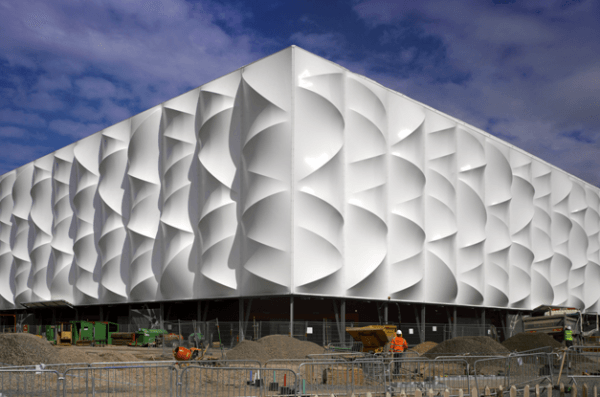Way back in 2005, when this summer’s Olympics were just a twinkle in London’s eye, the city’s Olympic committee worked with BioRegional (a U.K. non-profit) and the World Wildlife Federation (WWF) to craft a set of sustainability strategies that were to become the overriding theme of the city’s bid to host the games. That theme emphasized sustainability at every level, under the motto of “A One Planet Olympics” — and in 2010, the London Olympic Authority announced plans to make the London 2012 Olympics the “Greenest Olympics ever” by ensuring that they were fully sustainable and as low carbon as possible.
The fact that this summer’s games are the greenest on record has been well established, and its focus on green building is a key element of that. According to the Alliance to Save Energy, the Olympic Park’s permanent structures are responsible for 58 percent fewer carbon emissions than if they had been built to the U.K.’s 2006 building standards. The Park’s other structures are temporary, and were designed to be recycled into other buildings and materials when they’ve served their tour of duty this summer.

Another key sustainability feature of the Olympic Park is the fact that London currently has plans to transform the Olympic Park land into one of the largest parks in Europe, including at least 100 acres of natural habitat.
But there has been some controversy over whether the London Olympics has in fact achieved its lofty environmental goals for this summer’s games and — once again — the built environment is a key factor.
London’s Olympic plan included, at the outset, green building measures like water recycling, cutting the carbon footprint of all construction projects in half, and sourcing 25% of each project’s materials from recycled sources. But as the games drew closer, officials began to distance themselves from their original targets and spoke instead of “reducing” and “mitigating” the carbon footprint of the games.

The problem with achieving this goal of near-zero carbon emissions while building a modern Olympic Park is the sheer amount of construction projects required. To their credit, the London Olympics Authority made good on its promise to reuse or recycle 90 percent of construction waste, and brought sustainable design principles to a number of iconic green buildings. Still, more than half the CO2 emissions associated with the games arose from the construction process.
In order to make up for those emissions, this summer’s Olympics didn’t turn to the significant renewable energy projects it had outlined in its original sustainability plan. BioRegional’s executive director, Sue Riddlestone, was quoted as saying, in a recent release, “We were especially disappointed about the failure to meet the renewable energy targets,” even though, she went on to note, she knew “they tried.” The Authority has installed a handful of vertical wind turbines, as well as on-site combined heating and cooling and a power plant with biomass boilers (which can also burn natural gas), but no one really knows how much energy these sources produce. What is known is that the London Olympics have purchased a whole lot of carbon offsets to compensate for its emissions, the lion’s share of them generated via construction.
Carbon offsets are certainly not without merit, as they basically mean that the Olympics will pay penance by funding environmental projects, doing eco-good in equal proportion to the eco-bad of this summer’s games. But it’s certainly not the deep-green vision of sustainability that was envisaged at the outset of London’s bid for the games. In fact, as Inhabitat notes, this ‘pay-to-pollute’ scheme has drawn a lot of criticism, especially from those who see it as a blank check for developed countries with a lot of cash laying around to pollute as much as they like without actually doing anything to cut their emissions.
And yet, even the Games’ green detractors have acknowledged that no Olympic organizers have worked harder to make this massive event more environmentally responsible than any Olympics before, and that’s a commitment apparent nowhere more than in its buildings. These include the main Olympic Stadium, the lightest ever built, which seats 80,000 seat stadium and boasts a whole host of sustainable construction features, including rainwater harvesting, a fabric roof and various recycled materials.

The most iconic of these buildings, however, is the Velodome, which has been been characterized as the most energy-efficient venue within Olympic Park. Its green features include efficient lighting, rainwater harvesting, sustainable materials, thick insulation, intelligent building controls and 100 percent natural ventilation — this last an especially impressive feat, as the venue that requires different temperatures for athletes than spectators. Other green buildings that have drawn praise are the London Olympics’ Basketball Arena and Aquatics Center, both of which make use of phthalate-free PVC wrap that will be recycled after the games conclude this weekend.
In a recent interview with the New York Times, David Stubbs, the head of sustainability for the London Organizing Committee of the Olympic and Paralympic Games, indicated that the Olympic Committee realized early on that the carbon footprint of its built environment would likely surpass that of travel or waste, and consequently chose temporary structures for much of the park, constructed largely of existing (rather than bespoke) materials. “Even for the permanent structures,” he said, “we tried to reuse existing material as much as possible. For the steel used around the top of the Olympic Stadium, we used gas main pipes that were surplus to a project from up north. They had already been manufactured and were available, so this saved time, saved budget and it saved carbon by avoiding making new material.”
All of which, all told, illustrates the serious thought and effort that was given to lightening the heavy carbon footprint of even the greenest built environment at the Olympic scale.